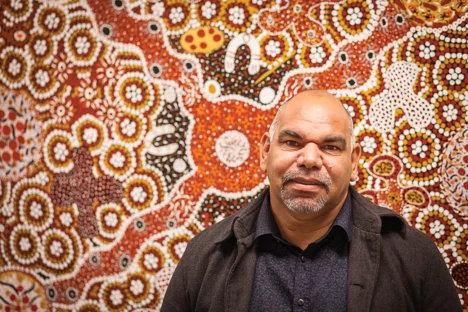A Gleam of Truth
December 1, 2005
Nathan Brown looks at the “next big thing”-the movie version of C S Lewis’s The Lion, the Witch and the Wardrobe.
“The Lion all began with a picture of a faun carrying an umbrella and parcels in a snowy wood. This picture had been in my head since I was about 16. Then one day, when I was about 40, I said to myself: ‘Let’s try to make a story about it,‘” C S Lewis reflected in a piece published in the Radio Times in 1960, 10 years after the first publication of The Lion, the Witch and the Wardrobe.
“At first I had little idea how the story would go. But then suddenly Aslan came bounding into it… . I don’t know where the Lion came from or why he came. But once he was there he pulled the whole story together. And soon he pulled the six other Narnian stories in after him.”
And so began one of the best-loved and most widely read children’s series in the past half-century. The Lion, the Witch and the Wardrobe is the second in the seven-part Chronicles of Narnia, which have now sold more than 85 million books and been published in 29 languages.
This month the story is retold in a new way with the release of the movie adaptation. Undoubtedly a new group of fans will discover these stories and a new generation of readers will be inspired to explore the adventures of Narnia.
The Storyteller
One could hardly imagine a less likely author for a series of children’s stories. Lewis had no children of his own and only married in the last years of his life. He spent most of his life in the rarefied academic atmosphere of Cambridge and Oxford Universities, published obscure but well-respected literary criticism and after a number of years as an avowed atheist became a writer of a variety of works of popular theology and Christian apologetics.
Lewis was born in 1898 in Belfast, Ireland, and his first years were happy. But his mother’s death when Lewis was just nine broke up the security of home and shook his child’s faith. He was sent away to boarding school and amid the rigours of a stern, classical education, he completely abandoned faith in God.
Lewis became a tutor at Magdalen College, Oxford and, later, Professor of Medieval and Renaissance Literature at Cambridge University. However, it is his return to Christian faith and his subsequent writing across a number of genres for which he is best remembered.
As well as including many features of common autobiography, Surprised by Joy is most significantly the narrative of Lewis’s road to conversion at age 33, at least partially influenced by colleagues such as J R R Tolkien, author of The Lord of the Rings. As he looked back over his experience, Lewis traced the development of his appreciation of a quality he refers to as “joy,” not mere happiness but rather an indefinable grandeur seemingly just beyond reach. Surprised by Joy follows this thread of joy until it leads him, rather reluctantly, to God—“the source from which those arrows of Joy had been shot at me ever since childhood.”
Significantly, he found many of these glimpses of joy in his love of stories, mythology and literature. Even in stories that have been simplified and dismissed as children’s stories, Lewis saw profound significance. He spoke of a possible higher reality behind such stories when he described the myths and stories passed down through history as “a real though unfocused gleam of divine truth falling on human imagination.”
Lewis became a prolific writer and speaker for Christianity. He came to prominence during World War II with a series of radio broadcasts on the BBC explaining what he termed “mere Christianity.” These talks were published under that title and Lewis became a regular on the lecture circuit of his day.
Lewis was established as a voice for rational Christianity and his writing found ever-growing audiences. His writings include autobiography, theology and philosophy, apologetics, literary criticism, poetry and fiction, ranging from children’s stories to science fiction.
Lewis died in 1963, but his influence as a writer has continued to grow. His work consistently appeared on lists of the most significant Christian writing of the 20th century put together around the turn of the century. Now, the movie adaptation of his best-loved story begins a new chapter in Lewis history.
Filming A Classic
Of course, there is a real risk that comes with bringing a popular book to the screen and this is perhaps particularly so in the case of a story in which generations have found various depths of meaning.
The producers of The Lion, the Witch and the Wardrobe have been well aware of this pressure and one of their responses has been to invite Lewis’s stepson, Douglas Gresham, to work as a creative consultant on the set of the film.
Gresham was the son of Joy Gresham, an American who began a friendship with Lewis by mail in 1950. Lewis and Joy met in the early 1950s and Douglas first met Lewis in 1955. Lewis legally married Joy in 1956 to enable her to stay in England.
Soon after, Joy discovered she had cancer. The shared suffering brought the two closer together and they were married by a clergyman in 1957. An intensely happy relationship was shadowed by Joy’s continuing battle with cancer and ended in Joy’s death in 1960. During this time, Douglas Gresham lost his mother but gained a stepfather, with whom he shared the pain of their loss.
The third book in the Narnia series, The Horse and His Boy, is dedicated to David and Douglas Gresham and it has come to Douglas to oversee the stories coming to life. He spent five weeks in New Zealand, working with the film crews and producers.
“Making the movie has been a dearly held ambition and project for me for about thirty years,” Gresham said recently in an interview with Narniaweb. “My children remember me dreaming, scheming, planning, and talking about it all their lives. So every aspect of it is important to me. I suppose I represent [C S Lewis] himself as a sort of creative ambassador. The aim of this is to use my abilities, knowledge and experience to make this movie as good as we can possibly make it.”
Gresham admits this has been a challenge. “As a Narnian purist I feel that any and every change from the original book is bad and thus have to contend with my emotional attachment to the book warring with my intellectual faculties and understanding of filmmaking. I have probably been a pain in the neck at times to my colleagues in the production,” he reflected.
A Gleam Of Divine Truth
Book lovers and film audiences across the world will be able to judge Gresham’s contribution to this work for themselves in coming weeks. But for both Gresham and Lewis the greater hope would be that audiences will somehow be challenged by the bigger story behind the story.
Lewis emphasised his stories were primarily stories. “Some people think that I began by asking myself how I could say something about Christianity to children,” he wrote, “then fixed on the fairy tale as an instrument; then collected information about child psychology and decided what age group to write for; then drew up a list of basic Christian truths and hammered out ‘allegories’ to embody them. This is all pure moonshine. I couldn’t write in that way at all… . At first there wasn’t even anything Christian about them; that element pushed itself in of its own accord. It was part of the bubbling.”
But at the same time he recognised the possibility that a “gleam of divine truth” may be seen in such stories and that such a format may indeed be most effective in revisiting a story many people think they know. “But supposing that by casting all these things into an imaginary world, stripping them of their stained-glass and Sunday school associations, one could make them for the first time appear in their real potency?”
Lewis was not hesitant in highlighting this significant aspect of his stories. One of his remarkable characteristics was a commitment to personally answer every letter he received from his many readers. It was at times quite demanding and, as his Chronicles of Narnia became more widely known, many letters came from children to whom he responded, prompt-ing them toward the greatest story.
To one correspondent, he asked, with a creative twist:
“Has there ever been anyone in this world who:
(1) Arrived at the same time as Father Christmas.
(2) Said he was the son of the Great Emperor.
(3) Gave himself up for someone else’s fault to be jeered at and killed by wicked people.
(4) Came to life again.
5) Is sometimes spoken of as a Lamb… .
Don’t you really know His name in this world. Think it over and let me know your answer.”
With the release of The Lion, the Witch and the Wardrobe this month, a new audience will be challenged to think it over and consider not just another story of another world but the story of God in this world. That’s the story most worth our attention.








